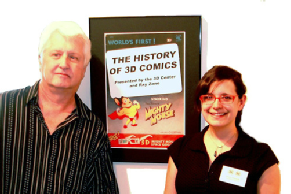 Talking 3D Comics
Talking 3D Comics
A conversation with Annie Dubinsky
by Ray Zone
On July 19, 2007 an exhibition on “The History of 3D Comics” opened at the 3D Center. Running through September 9, the exhibition was the brainchild of Associate Director Annie Dubinsky.
At the opening reception, Annie and I discussed the genesis and format of the show. Though 3D comics have been shown in museums and galleries before, this landmark exhibit is the first to be entirely dedicated to three-
Dubinsky: We received a donation from one of our local members at the end of 2006 of both 1950s and 1980s 3-
Zone: What were your primary sources for your research?
Dubinsky: The primary sources were you! (laughter) I did a lot of research at the library. The Amazing 3-
But for the most part, the intention behind the exhibit was to show where it all started and then to highlight your work in the 1980s.
Zone: This is very interesting how you’ve got the comics displayed with a little schematic or guide indicating the titles.
Dubinsky: Yeah. Originally we thought about printing the 3D comic covers really huge. The problem is not just space because we wanted to exhibit as many as we could. But also the printing costs were starting to get a little expensive. And here’s the other thing that made me really decide on printing them to size. Because there was going to be a mixture of actual comics and scans, I just wanted the consistency. And I thought it would look good to have them tiled. We thought it would look good to mat everything. With the logistics of displaying this, since we’re mostly volunteers here, it was a little more convenient to do it this way. It gave a nice grid. We could match them and take the comics out after the show.
Zone: It looks great.
Dubinsky: This way with the little legends we could show people who did the artwork and which issue it is. There’s no real rhyme or reason or chronological order. It’s just two 1950s panels and then three 1980s panels.
Zone: Did you find it a little baffling when I pointed out the erratic nature of comic book artist documentation?
Dubinsky: Yes. Yes, I did. I didn’t know where to start so I just took your word. I just took your suggestion and only documented where I could.
Zone: Your narrative shows considerable research. And it is potentially a very complex story.
Dubinsky: It is, And this doesn’t even include the history of 3-
Zone: Is this the first show you’ve instigated, spear-
Dubinsky: I’ll be calling you. (laughter)